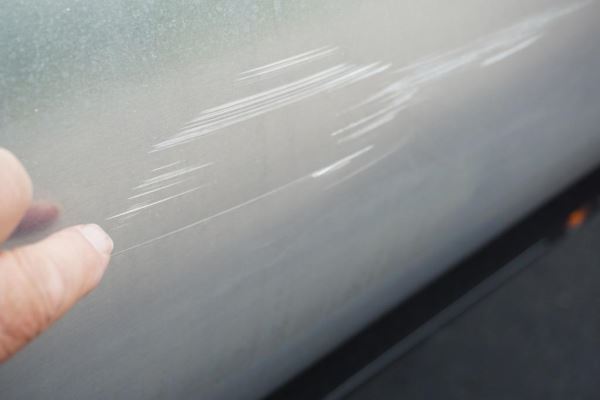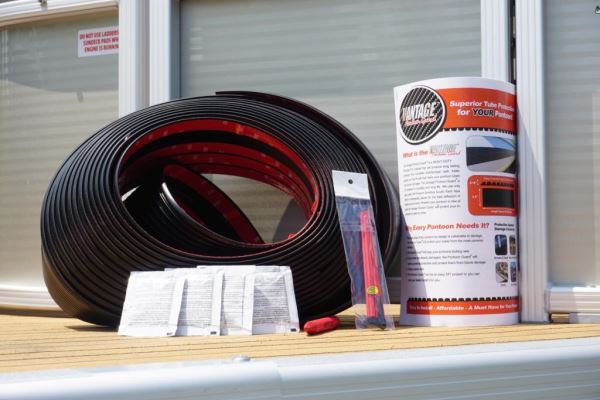
During our first years of boating over a half a century back, I always remember the saying “Water doesn’t sink boats; rocks do!” I am sure all pontoon owners want to protect their investment and maintain the appearance of their boat. In this DIY article I’m going to recap the installation of a superior pontoon protection product called VANTAGE Pontoon Guards, which will protect the vulnerable outer sides of the ‘toons on a pontoon boat.
 As a family of four back 35-plus years or so ago, we crossed Lake Michigan—a 68-mile crossing to the other side from a launch ramp in upper Wisconsin. The three most important things a boater must realize (in order) when boating on any of the Great Lakes is weather, weather and weather.
As a family of four back 35-plus years or so ago, we crossed Lake Michigan—a 68-mile crossing to the other side from a launch ramp in upper Wisconsin. The three most important things a boater must realize (in order) when boating on any of the Great Lakes is weather, weather and weather.
First plotting our course on chart #14900, then checking NOAA weather on one of our two Marine VHF radios, we cast off and steered our compass heading (no GPS back in those days) crossing to Grand Haven, Mich. Since the city supplied free dockage along the city’s inner breakwater, we tied off after our long crossing and securely set a few large bumpers out to protect our trusty little vessel for the night. We then walked into town for a tour and had a nice dinner. Upon returning, the winds had picked up considerably and were blowing directly down the main channel off Lake Michigan, creating massive surging and rolling 3- to 4-foot waves! To protect the conventional hull of our 25-foot trailerable cruiser boat from being heavily damaged, we had to do something and quickly, as our regular large boat bumpers just lifted and did nothing to protect the hull!
 We noted a nearby gas station on our walk to town and remembered that behind it was a huge pile of used discarded tires. Our son Scott and I quickly ran back to ask the owner if we could have a few tires and explained our plight. He was happy to help and we quickly rolled and carried all the auto-sized tires we could bring back to the city walls.
We noted a nearby gas station on our walk to town and remembered that behind it was a huge pile of used discarded tires. Our son Scott and I quickly ran back to ask the owner if we could have a few tires and explained our plight. He was happy to help and we quickly rolled and carried all the auto-sized tires we could bring back to the city walls.
We lowered them over the side of the concrete wall, securing each and every one along the entire length of the hull, thus protecting our little boat from severe damage. The idea worked well, but the high winds made it a very sleepless night on the boat. In the morning light our little vessel had a lot of black tire marks along the port side, but to our delight, no damage. As for the other boats tied off along that same concrete wall during that long night, most were damaged quite severely. Rub rails had been destroyed, hulls gouged, etc., and basically there were a lot of really upset boaters, to say the least.
 Shifting To ‘Toons
Shifting To ‘Toons
After decades of conventional type hulls—fiberglass mainly—we decided this season to purchase our first pontoon boat and are now asking ourselves, “Why did we wait so long?” My wife Sandy and I are still in disbelief at all the room. We custom ordered a three-pontoon model, which added to the outstanding performance with a hefty four-stroke 150hp outboard bolted to the stern. Quick launching and retrieving (float off, power on) was never so easy!
We could hardly wait for our first outing, the shake down, break down trial launch. We checked to make sure the bumpers were in place, the fuel tank filled (ethanol-free, of course) and because of over 50 years of habit, Sandy asked me where the bilge blower switch was and wanted to make sure the drain plug was in place. Oh my, we had to learn all over again! Reason being, there isn’t one on a pontoon boat!
 Maiden Voyage
Maiden Voyage
We had the ramp all to ourselves, wide enough to launch over five boats at a time. Sandy is always at the helm as we launch and retrieve. I do the tough work: backing the rig, parking and walking down the ramp for Sandy to “pipe me aboard.” That day was like most in early spring in Eastern Kentucky, sunny and warm, but that day the wind was also very strong. As we launched our boat, LOONY TOONS, off her new dual axle, 4-disc-braked trailer into Lake Cumberland’s clear waters for the first trial run, we were both ready and confident.
She slid nicely off into the lake and after parking I quickly took my seat behind the helm before Sandy’s fingers had a chance to warm the steering wheel. About then a strong gust of wind blew us quickly across the top of the water. We had all our new and large bumpers out and ready, but to no avail. Remembering quickly Grand Haven’s Lake Michigan, we were heading directly towards a large all-concrete floating dock! I winced painfully as I heard that sound of a fresh new aluminum pontoon against the old hard jagged concrete! I did clear the long and bulging ‘toon from further damage, but the dastardly deed was already done. It was a painful first day out for me, but as always, Sandy just supported me.
 On The Hunt
On The Hunt
That evening as I read over my latest issue of PDB magazine, a small advertisement towards the end pages caught my eye. It was a small ad for VANTAGE Pontoon Guards and it was the line “superior pontoon protection” that grabbed my attention. I contacted the company and proceeded to ask about their product.
“Is it easy to install, what colors are available, is it affordable and does it do as it advertises?” I asked. All my queries were answered and a package in rich black color arrived a few days later. Without any doubts, installing a set of protective VANTAGE Pontoon Guards would be much better than hanging six or seven used automobile tires along the side our pontoon.
Getting Started
 The VANTAGE Pontoon Guards are available in assorted lengths including a 36-foot kit (fits up to a 22-foot pontoon), a 42-foot kit (fits up to a 25-foot pontoon) and lastly the 50-foot kit (fits up to a 29-foot pontoon).
The VANTAGE Pontoon Guards are available in assorted lengths including a 36-foot kit (fits up to a 22-foot pontoon), a 42-foot kit (fits up to a 25-foot pontoon) and lastly the 50-foot kit (fits up to a 29-foot pontoon).
The kits are cut in half in advance for greater ease of installation. I discovered many extra uses for leftover VANTAGE Pontoon Guards product, like using it on your trailer, but I’ll get to that later. The Guards are manufactured of a heavily padded, multi-ribbed rubber/vinyl-type thick material with a space age adhesive pre-installed. They should be installed only in mild temperatures as per the included instructions.
Our new ‘toon already had a clean pontoon surface so no heavy cleaning prep was required for us, just a healthy rubbing with common alcohol—rubbing alcohol that is, no Kentucky Jim Beam.
I then went over it with a paper towel, white vinegar and a light scuffing with a 000 steel wool pad, then wiped it again with a clean cloth and it was ready. Note, the surfaces must be thoroughly cleaned and this can’t be stressed enough! It took me less than a half an hour to prep each pontoon tube because our boat is new and is always stored on the trailer. Of course, if your boat is kept in the water, the buildup will be greater and will require much more cleaning effort before applying the product.

Tale Of The Tape
The next step is to measure the “top crown” of the tube. This utmost outer radius varies depending on the ‘toon’s diameter. I used a common flexible plastic desk ruler that bends the radius easily. I utilized the boat’s trim structure to measure down and along the full length of the pontoons (with our specific measurement being 5 and 3/4 of an inch). I then used the kit-supplied red marker and marked about every 12 inches along the length of the pontoon tube. Next I used painter’s tape that I purchase locally to mark the position of where the Guard material is to be adhered by bridging those red marks then attaching the green tape as a guide when you place the Pontoon Guards.
Permanent Results
The next step is to apply a chemical activator to the ‘toon’s surface—which was supplied in small sealed packets—onto the thoroughly cleaned pontoons where the Guards are to be located permanently.
The Guards have four red removable cellophane strips, the single red strip at the top (upper) part of the applied Guard. Starting at the bow behind the first weld on the pontoon, you simply pull the protective cellophane strips away from the Guards, but only 8 to10 inches at a time. Then work your way to the stern, pulling the red tape from the Guards product at a comfortable rate.
 Push Firmly
Push Firmly
You have only one chance because once the Guards touch the pre-activated pontoon surface, it is almost impossible to retry. Take your time, position correctly at the start and work your way to the end using the green painter’s tape as your guide.
Happy Boating
The VANTAGE Pontoon Guards have been installed over two months now and at speeds of over 40 mph I do not show any indications of peeling, lifting or loosening—mostly due to the “Space-age adhesives” that are part of the design. Once applied, they are on for the life of the boat.
Another advantage is our first deep gouge from our first day out is now covered completely with the VANTAGE Pontoon Guards so no one will ever know. The product also works nicely on those slightly dented tubes too.
As for the scrap pieces, I have applied them to assorted places on our new trailer like on the fenders and the rear areas that are susceptible to damage when retrieving your pontoon boat. I guess you could say that’s yet another advantage of VANTAGE.
Click on images in gallery to view photo-by-photo details.

